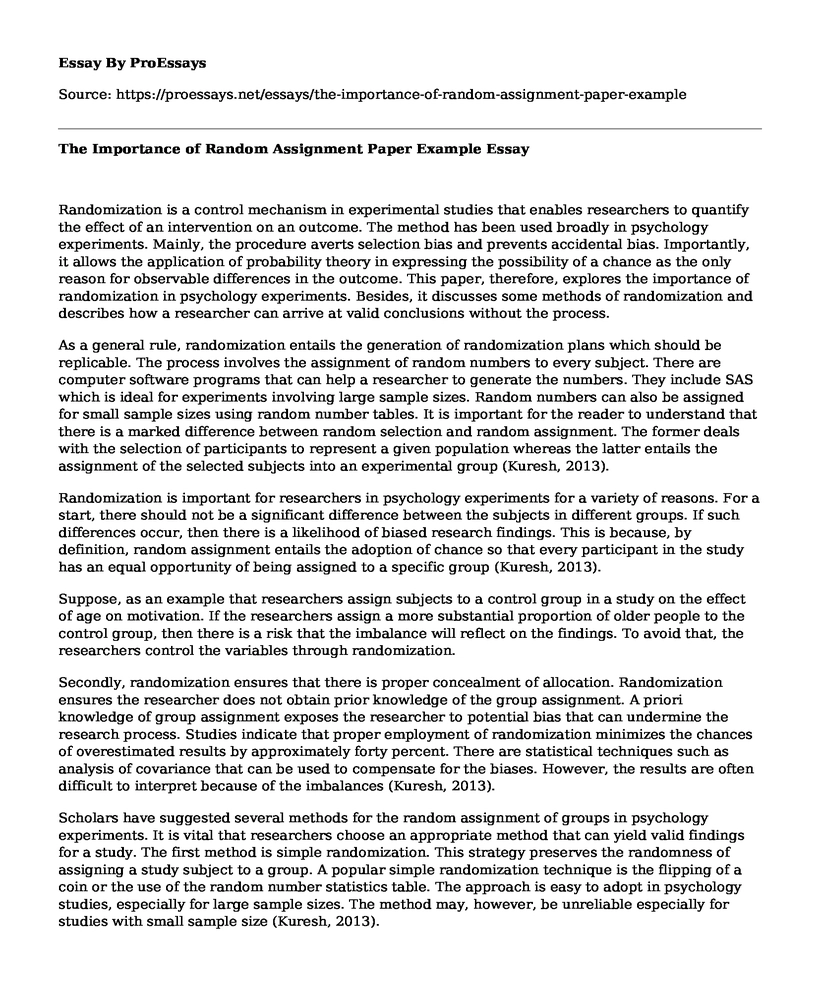Randomization is a control mechanism in experimental studies that enables researchers to quantify the effect of an intervention on an outcome. The method has been used broadly in psychology experiments. Mainly, the procedure averts selection bias and prevents accidental bias. Importantly, it allows the application of probability theory in expressing the possibility of a chance as the only reason for observable differences in the outcome. This paper, therefore, explores the importance of randomization in psychology experiments. Besides, it discusses some methods of randomization and describes how a researcher can arrive at valid conclusions without the process.
As a general rule, randomization entails the generation of randomization plans which should be replicable. The process involves the assignment of random numbers to every subject. There are computer software programs that can help a researcher to generate the numbers. They include SAS which is ideal for experiments involving large sample sizes. Random numbers can also be assigned for small sample sizes using random number tables. It is important for the reader to understand that there is a marked difference between random selection and random assignment. The former deals with the selection of participants to represent a given population whereas the latter entails the assignment of the selected subjects into an experimental group (Kuresh, 2013).
Randomization is important for researchers in psychology experiments for a variety of reasons. For a start, there should not be a significant difference between the subjects in different groups. If such differences occur, then there is a likelihood of biased research findings. This is because, by definition, random assignment entails the adoption of chance so that every participant in the study has an equal opportunity of being assigned to a specific group (Kuresh, 2013).
Suppose, as an example that researchers assign subjects to a control group in a study on the effect of age on motivation. If the researchers assign a more substantial proportion of older people to the control group, then there is a risk that the imbalance will reflect on the findings. To avoid that, the researchers control the variables through randomization.
Secondly, randomization ensures that there is proper concealment of allocation. Randomization ensures the researcher does not obtain prior knowledge of the group assignment. A priori knowledge of group assignment exposes the researcher to potential bias that can undermine the research process. Studies indicate that proper employment of randomization minimizes the chances of overestimated results by approximately forty percent. There are statistical techniques such as analysis of covariance that can be used to compensate for the biases. However, the results are often difficult to interpret because of the imbalances (Kuresh, 2013).
Scholars have suggested several methods for the random assignment of groups in psychology experiments. It is vital that researchers choose an appropriate method that can yield valid findings for a study. The first method is simple randomization. This strategy preserves the randomness of assigning a study subject to a group. A popular simple randomization technique is the flipping of a coin or the use of the random number statistics table. The approach is easy to adopt in psychology studies, especially for large sample sizes. The method may, however, be unreliable especially for studies with small sample size (Kuresh, 2013).
The next method is block randomization. This approach is suitable for generating equal sample sizes within different groups. Each block consists of a predetermined and constant number of subjects within a group. The size of the block is at the discretion of the researcher and often occurs in multiples of the number of groups (Kuresh, 2013).
Another technique is the stratified randomization. This method of randomization is applicable mostly where researchers need to manage the impact of covariates. Through this approach, the researcher can realize balance within the groups with regards to the characteristics of the subjects. Stratified randomization occurs when a researcher generates distinct blocks for the covariates and assigns the subjects to them. After this process, the researcher uses simple randomization in every block to assign subject to the groups. One limitation of stratified randomization is that it applies only when the researcher has identified all the subjects before assignment into groups. Also, the approach requires sufficient knowledge of the baseline features of all the subjects (Kuresh, 2013).
Conclusion
It is possible to conclude studies even if the design does not meet the randomization criteria. Firstly, randomization is meant to produce sub-groups which essentially represent the population from which the sample is taken. Now, suppose the randomization process yields groups that are not equivalent, it is still possible to draw conclusions. First, the sub-groups remain representative of the population. That is, a researcher can take the conclusion on the sub-group as representative of the whole population (Saint-Mont, 2015).
Elsewhere, studies show that randomization offers minimal help. Saint-Mont (2015) finds that the comparability principle can be used to draw conclusions. Comparability has everything to do with the features or characteristics of the units under experiment. That is, comparability exists when the units of the experiment are as similar to one another as possible. A researcher is, therefore, able to draw conclusions without the necessity of randomization.
References
BIBLIOGRAPHY \l 1033 Kuresh, K. (2013). An overview of randomization techniques: An unbiased assessment of outcome in clinical research. J Hum Reprod Sci, 8-11.
Saint-Mont, U. (2015). Randomization does not help much, comparability does. PLOS One, 10-15.
Cite this page
The Importance of Random Assignment Paper Example. (2022, Sep 22). Retrieved from https://proessays.net/essays/the-importance-of-random-assignment-paper-example
If you are the original author of this essay and no longer wish to have it published on the ProEssays website, please click below to request its removal:
- Costco in Colombia SWOT Analysis
- Action Research and Organizational Development Essay
- Nicotine Replacement Therapy Research Paper Example
- Paper Example on Qualitative Data Analysis Software
- Use of Deceptive Methods in Psychological Research - Essay Sample
- Dunkin' Donuts Analysis Paper Example
- Causes and Impacts of Racial Microaggressions and How Black Female Students Integrate These Experiences







